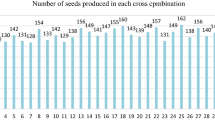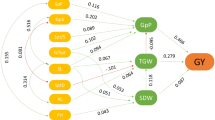Summary
Grain filling rate in wheat (Triticum aestivum L. emend. Thell.) positively influences grain yield under a wide range of conditions. The effective utilization of this trait in breeding depends on an understanding of its genetic control. A study was, therefore, conducted to determine the genetic basis of grain filling rate in six crosses of wheat. Higher order genic interactions and/or linkage were important in the genetic regulation of grain filling rate (GFR) in the majority of crosses. Additive ([d]) and dominance ([h]) gene effects were important in the control of GFR in main ears (ME) and whole plant ears (WPE). Additive and additive × additive epistatic effects were the most important in the genetic control of GFR in last ears (LE). Location effects on genetic effects for GFR were significant (P < 0.05) in all ear types of some crosses except in ME. Genotype × environment interaction effects were important (P < 0.001) in LE and WPE.
It was concluded that the inheritance of GFR is complex and is dependent on ear type. Breeding procedures that facilitate the exploitation of non-additive and additive gene effects were recommended for the genetic improvement of grain filling rate of wheat.
Similar content being viewed by others
References
Amaya A.A., R.H.Busch & K.L.Lebsock, 1972. Estimates of genetic effects of heading date, plant height and grain yield in durum wheat. Crop Sci. 17: 478–481.
Bhullar B.S., K.S.Gill & G.S.Makal, 1978. Genetic analysis of protein in wheat. In: S.Ramanujam (Ed.). Proceedings of the Fifth International Wheat Genetics Symposium, pp. 613–625. Indian Agriculture Research Institute, New Delhi, India.
Bingham J., 1967. Investigations on the physiology of yield in winter wheat, by comparison of varieties and by artificial variation in grain number per ear. J. Agric. Sci., Cambridge 68: 411–422.
Bingham J., 1987. Exploitation of heterosis in wheat breeding. Heredity 59: 313.
Bryne I. & C.D.Rosmusson, 1974. Eecurrent selection for mineral content in wheat and barley. Euphytica 23: 241–249.
Busch R.H., J.C.Janke & R.C.Frohberg, 1974. Evaluation of crosses among high and low yielding parents of spring wheat (Triticum aestivum L.) and bulk prediction of line performance. Crop Sci. 14: 47–50.
Busch R.H. & K.Kofoid, 1982. Recurrent selection for kernel weight in spring wheat. Crop Sci. 22: 568–572.
Busch R.H., K.A.Lucken & R.C.Frohberg, 1971. F1 hybrids versus random F5 line performance and estimates of genetic effects in spring wheat. Crop Sci. 11: 357–361.
Cross H.Z., 1975. Diallel analysis of duration and rate of grain filling of seven inbred lines of corn. Crop Sci. 15: 532–535.
Egli D.E., E.L.Ramseur, YuZhen-wen & C.H.Sullivan, 1989. Source-sink alterations affect the number of cells in soyabean cotyledons. Crop Sci. 29: 732–735.
Frankel O.H., B.Shineberg & A.Munday, 1970. The genetic basis of an invariant character in wheat. Heredity 24: 571–591.
Fussell L.K. & C.J.Pearson, 1978. Course of grain development and its relationship to black region appearance in Pennisetum americanum. Field Crops Research 1: 21–31.
Gebeyehou G., D.R.Knott & R.J.Baker, 1982. Relationships among durations of vegetative and grain filling phases, yield components and grain yield in durum wheat cultivars. Crop Sci. 22: 287–290.
Gill K.S., S.S.Dhillon & K.S.Bains, 1972. Combining ability and inheritance of yield components in crosses involving Indian and exotic wheat germplasm. Indian J. Genet. Plant Breeding 32: 421–430.
Hallauer A.R. & J.B.Miranda, 1981. Quantitative genetics in maize breeding. Iowa State University Press, Ames, USA.
Hartung R.C., C.G.Poneleit & P.L.Cornelius, 1989. Direct and correlated responses to selection for rate and duration of grain fill in maize. Crop Sci. 29: 740–745.
Hayman B.I., 1958. The separation of epistatic from additive and dominance variation in generation means. Heredity 12: 371–390.
Housley T.L., A.W.Kirleis, H.W.Ohm & F.L.Patterson, 1982. Dry matter accumulation in soft red winter wheat seeds. Crop Sci. 22: 290–294.
Jain, K.B.L. & G. Singh, 1978. Estimates of additive, dominance and additive × additive genetic variatnce in common wheat. In: S. Ramanujam (Ed.). Proceedings of the Fourth Wheat Genetics Symposium 2: 606–612.
Jenner C.F., 1970. Relationship between levels of soluble carbohydrates and starch synthesis in detached ears of wheat. Austr. J. Biol. Sci. 23: 991–1003.
Jenner C.F., 1976. Physiological investigations on restrictions to transport of sucrose in ears of wheat. Austr. J. Plant Physiol. 3: 337–347.
Jenner C.F. 1980. Effects of shading or removing spikelets in wheat: Testing assumptions. Austr. J. Plant Physiol. 7: 113–121.
Jenner C.F. & A.J.Rathjen, 1972a. Factors limiting the supply of sucrose to the developing wheat grain. Ann. Bot. 36: 729–741.
Jenner C.F. & A.J.Rathjen, 1972b. Limitations to the accumulation of starch in the developing wheat grain. Ann. Bot. 36: 743–754.
Ketata H., E.L.Smith, L.H.Edwards & R.W.McNew, 1976. Detection of epistatic, additive and dominance variation in winter wheat (Triticum aestivum L. em. Thell.). Crop Sci. 16: 1–4.
Manness N.O., 1989. High temperature limitation for enzymatic sugar conversion in wheat kernels. Wheat, Barley and Triticale Abstr. 6: 422.
Mashiringwani N.A. & M.A.Schweppenhauser, 1992. Phenotypic characters associated with yield adaptation of wheat to a range of temperature conditions. Field Crops Res 29: 69–77.
Mather K. & J.L.Jinks, 1971. Biometrical genetics. Chapman and Hall Ltd., New Fetter Lane, London EC4.
McFerson J.K. & K.J.Frey, 1991. Recurrent selection for protein yield of oat. Crop Sci. 31: 1–8.
Meterlerkamp, H.R.R., 1975. Irrigation scheduling by means of class ‘A’ pan evaporation. Rhodesia Agric. J. Techn. Bull. No. 16.
Millet E. & M.J.Pinthus, 1980. Genotypic effects of maternal tissues of wheat on its grain weight. Theor. Appl. Genet. 58: 247–252.
Nass H.G. & B.Reisser, 1975. Grain filling period and grain yield relationships in spring wheat. Can. J. Plant Sci. 55: 673–678.
Pathak N.N. & D.P.Nema, 1983. Gene action and heterosis in a spring wheat cross under high temperature and moisture stress conditions. In: S.Sakamoto (Ed.). Proceedings of the Sixth International Wheat Genetics Symposium, pp. 555–561. Plant Germplasm Institute, Kyoto University, Kyoto, Japan 1983.
Perenzin M., F.Ferrari & M.Motto, 1980. Heritabilities and relationships among grain-filling period, seed weight and quality in forty Italian varieties of corn (Zea mays L.). Can. J. Plant Sci. 60: 1101–1107.
Pinthus M.J. & E.Millet, 1978. Interactions among number of spikelets, number of grains and grain weight in the spikes of wheat. Ann. Bot. 42: 839–848.
Pinthus M.J. & Y.Sar-Shalom, 1978. Dry matter accumulation in the grains of wheat (Triticum aestivum L.) cultivars differing in grain weight. Ann. Bot. 42: 469–471.
Sanford D.A.van, 1985. Variation in kernel growth characters among soft red winter wheats. Crop Sci. 25: 626–630.
Simmons S.R. & R.K.Crookston, 1979. Rate and duration of growth of kernels formed at specific florets in spikelets of wheat. Crop Sci. 19: 690–693.
Singh, R.B. & S.L. Dwevidi, 1978. Biparental mating in wheat. In: S. Ramanujam (Ed.). Proceedings of the Fifth International Wheat Genetics Symposium 2: 671–679.
Sofield I., L.T.Evans, M.G.Cook & I.F.Wardlaw, 1977. Factors influencing the rate and duration of grain filling in wheat. Austr. J. Plant Physiol. 4: 785–797.
Srivastava R.B., R.S.Paroda & O.P.Luthra, 1980. Estimation of gene effects for components of yield in wheat. Cer. Res. Commun. 8: 515–520
Widner J.N. & K.L.Lebsock, 1973. Combining ability in durum wheat. I. Agronomic characteristics. Crop Sci. 13: 164–167.
Zianddin A., T.C.Radheyshyam & R.P.Katiyar, 1979. Combining ability and economic heterosis in bread wheat. Indian J. Agric. Sci. 49: 151–158.
Author information
Authors and Affiliations
Rights and permissions
About this article
Cite this article
Mashiringwani, N.A., Mashingaidze, K., Kangai, J. et al. Genetic basis of grain filling rate in wheat (Triticum aestivum L. emend. Thell.). Euphytica 76, 33–44 (1994). https://doi.org/10.1007/BF00024018
Received:
Accepted:
Issue Date:
DOI: https://doi.org/10.1007/BF00024018




